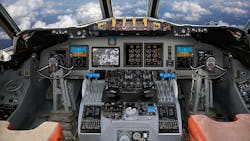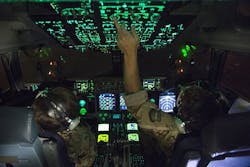It’s time: Avionics need to move to multicore processors
AUSTIN, Texas. 2018 will be the year certifiable multicore takes off, predicts Scott Engle, director of business development at Mercury Mission Systems, part of Mercury Systems in Andover, Massachusetts. “A majority of avionics today are running on single-core processors, or multicore processors with all but one core disabled,” Engle explains. That’s surprising, he says, given that everyone is walking around with smartphones that use multicore processors.
It’s time for a change and a move to multicore for modern avionics. “The future will be multicore systems in an integrated modular avionics (IMA),” rather than federated, architecture, Engle says. “Everything is integrated. The problem is you generally have to build it from the ground up, and that can be a challenge.”
The future of avionics will be much more information- or knowledge-driven – possibly deploying artificial intelligence (AI)/deep learning neural networks, Engle predicts.
Aerospace and defense (A&D) will learn from other markets, and incorporate advancements in technology from the automotive and AI communities, Engle says.
“Many systems we see are really stuck between federated systems and IMA; this is especially true in U.S. Department of Defense (DoD) programs in which there is never an opportunity to completely redesign,” Engle adds. To consolidate functionality into fewer subsystems, multicore is needed, he says.
Historical factors in CPU selection, Engle says, include: performance/power dissipation, obsolescence, technical readiness level (TRL) and/or certification history, and availability of design information. Future factors include all of the above, and determinism, isolation, software ecosystem, the flexibility of architectural choices, and uncertainty.
Problems unique to avionics include: system life cycles over 20-plus years, certification requirements, determinism, isolation, cost and time of certification, certification artifacts, and security. The root of the problem is shared resources, which most of the time creates some kind of interference. The amount of interference increases with the number of cores used. It might limit some of the architectural options, especially early on, Engle explains.
There’s less uncertainty surrounding multicore today vs. in the past. Certification authorities are further along, interference is being more understood, software and hardware companies are sharing information, and simple multicore designs are going through certifications. “We will learn a lot from those early multicore certification efforts,” Engle predicts.
Multicore certification is a team effort, Engle says. In the case of DO-297 Role Separation, the platform supplier, system integrator, and application suppliers work together. “IMA is pushing everyone to think in terms of systems, and tighter partnerships between hardware and software companies,” Engle says. “A huge number of potential architectural decisions may influence CPU selection.”
Industry’s comfort level around multicore is improving. Tighter collaboration with vendors is a must, Engle notes. Tighter collaboration between platform provider and customer will ease certification efforts.
Continue the embedded computing discussion
This discussion was one of many high-level, technical presentations at VITA’s Embedded Tech Trends (ETT), an annual conference on embedded computing technologies and trends, held this week in Austin, Texas. For more from ETT, visit http://www.intelligent-aerospace.com/search.html?q=Embedded+Tech+Trends
The go-to resource for Intelligent Aerospace technology news & information:
Covering key topics
Across all market segments
Subscribe to the free Intelligent Inbox e-newsletter: http://www.intelligent-aerospace.com/subscribe.html.
Connect on social media:
Keep pace with aerospace innovation and opportunities via your favorite social media channels. Connect with Intelligent Aerospace on Twitter (@IntelligentAero), LinkedIn,Google+, and Instagram.




